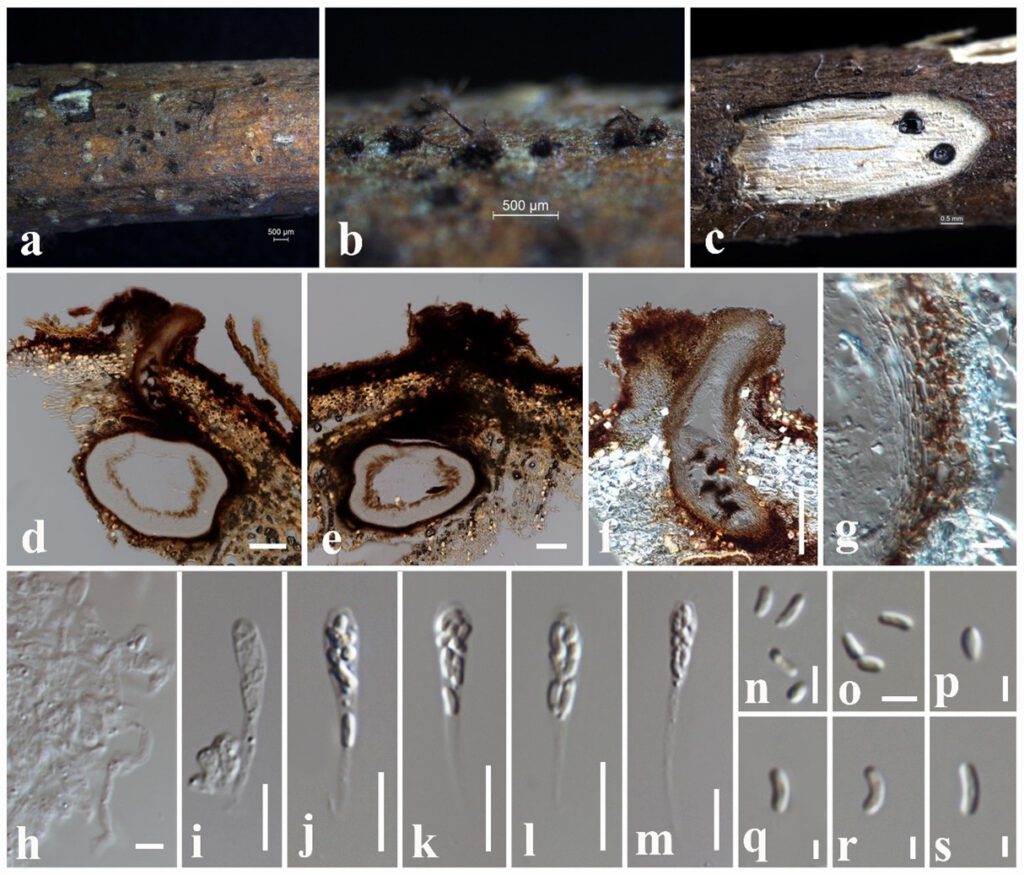Peroneutypa anomianthi N.I. de Silva, Lumyong & K.D. Hyde, in de Silva, Hyde, Lumyong, Phillips, Bhat, Maharachchikumbura, Thambugala, Tennakoon, Suwannarach & Karunarathna, Mycosphere 13(1): 1048 (2022)
Index Fungorum number: IF 559525, FacesofFungi number: FoF 10722
Etymology – Name reflects the host genus Anomianthus, from which the new species was isolated.
Holotype – MFLU 21-0242.
Saprobic on dead twigs attached to Anomianthus dulcis. Sexual morph: Stromata with poorly developed interior, solitary to gregarious, 1–5 locules, immersed, becoming raised to erumpent by a long ostiolar canal, dark brown to black, glabrous, circular to irregular in shape, arranged in longitudinally, with conspicuous, clustered, roundish to cylindrical prominent ostioles in the centre. Ascomata (excluding necks) 280–350 μm high, 350–450 µm diam. ( = 320 × 400 µm, n = 10), perithecial, immersed in a stroma, dark brown to black, globose to subglobose, glabrous, individual ostioles with long neck. ostiolar canals 320–360 μm high, 90–110 µm diam. ( = 340 × 100 µm, n = 10), cylindrical, sulcate, at the apex curved, periphysate. Peridium 20–30 µm wide, composed of two section layers, outer section comprising 4–5 layers, of relatively small, brown to dark brown, thick-walled cells, arranged in a textura angularis, inner part comprising 3–5 layers of flattened, hyaline cells of textura angularis to textura prismatica. Hamathecium composed of 2–3 μm wide, dense, cylindrical, septate, slightly swell at the basal cells, constricted at the basal septa, hyaline, paraphyses slightly swollen at the septa. Asci 26–36 × 3–5 ( = 29 × 4 µm, n = 20), unitunicate, cylindrical, 8-spored, urn-shaped, long pedicellate, apically rounded to truncate, with a J-, subapical ring. Ascospores 3–5 × 1–2 ( = 4.5 × 1.5 µm, n = 30), overlapping 1–2-seriate, hyaline to pale yellowish, allantoid, aseptate with smooth-walled. Asexual morph: Undetermined.
Culture characteristics– Colonies on PDA reaching 30 mm diameter after 1 weeks at 25°C, colonies from above: irregular, margin fimbriate, slightly raised, cottony, fluffy to fairly fluffy, white; reverse: cream at the margin, pale brown in the centre.
Material examined – Thailand, Chiang Rai Province, dead twigs attached to Anomianthus dulcis (Annonaceae), 4 April 2019, N. I. de Silva, AND6 (MFLU 21-0242, holotype), living culture, MFLUCC 21-0195.
GenBank numbers – ITS: OK393705.
Notes – A new strain MFLUCC 21-0195 forms an independent lineage that closely related to Peroneutypa polysporae (NFCCI 4392) and P. mangrovei (PUFD 526) with 99% ML statistical support in our phylogeny of combined ITS and tub2 sequence data. Peroneutypa polysporae differs from the new strain in having (113 × 12 µm), polysporous asci (Dayarathne et al. 2020). Peroneutypa mangrovei has small asci (17 × 3.5 µm) with short pedicellate (Phookamsak et al. 2019), while the new strain has large asci (29 × 4 µm) with long pedicellate. Peroneutypa polysporae was isolated on decaying wood of Suaeda monoica in India (Dayarathne et al. 2020) while P. mangrovei was isolated on decaying wood of Avicennia marina in India (Phookamsak et al. 2019). Peroneutypa comosa was isolated on rotten stems of Celtis tala in Buenos Aires in having (25–30 × 6–9 µm) asci and (5–7 × 2–2.5 µm) ascospores (Spegazzini 1881). The new strain was collected from dead twigs of Anomianthus dulcis in Thailand. Therefore, we introduced Peroneutypa anomianthi as a novel species based on morphology, phylogeny and host association.

Figure 6.67 Peroneutypa anomianthi (MFLU 21-0242, holotype). a–c Appearance of stromata on substrate. d, e Sections through stromata. f Ostiolar canal. g Peridium. h Paraphyses. i–m Asci. n–s Ascospores. Scale bars: b, c = 500 μm, d–f = 100 μm, g = 10 μm, h = 5 μm, k = 10 μm, i–m = 10 μm, n–s = 5 μm.
